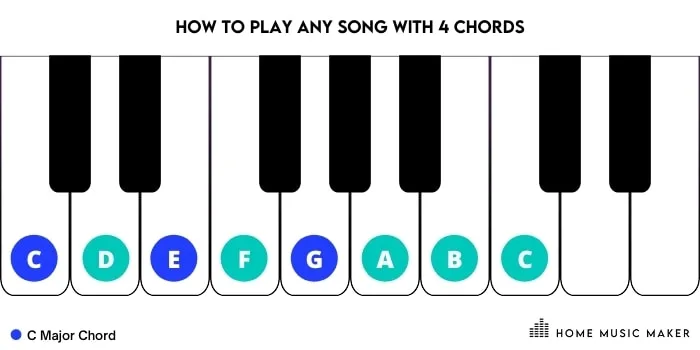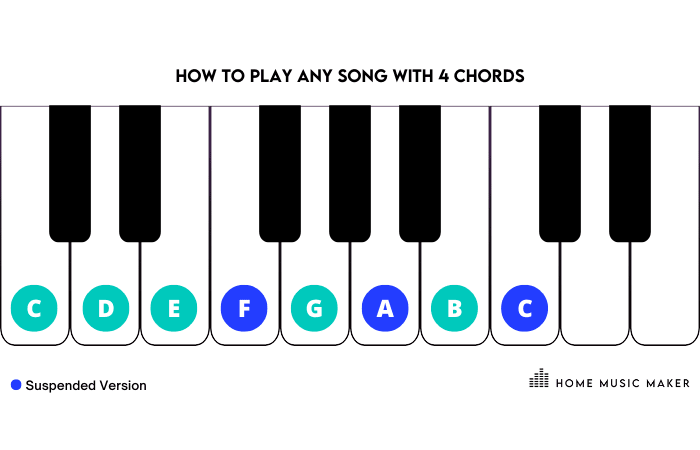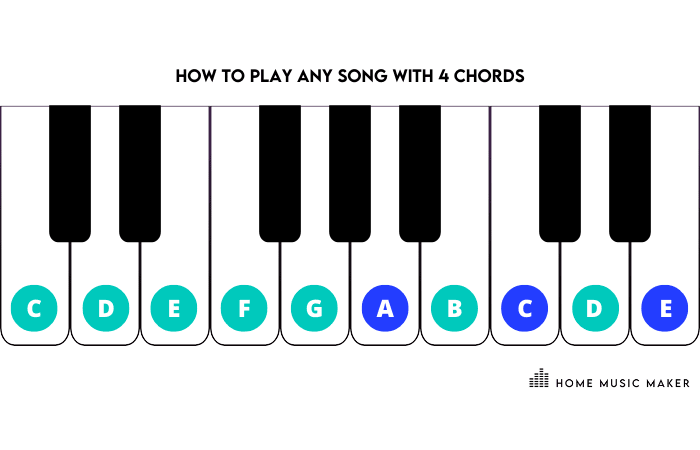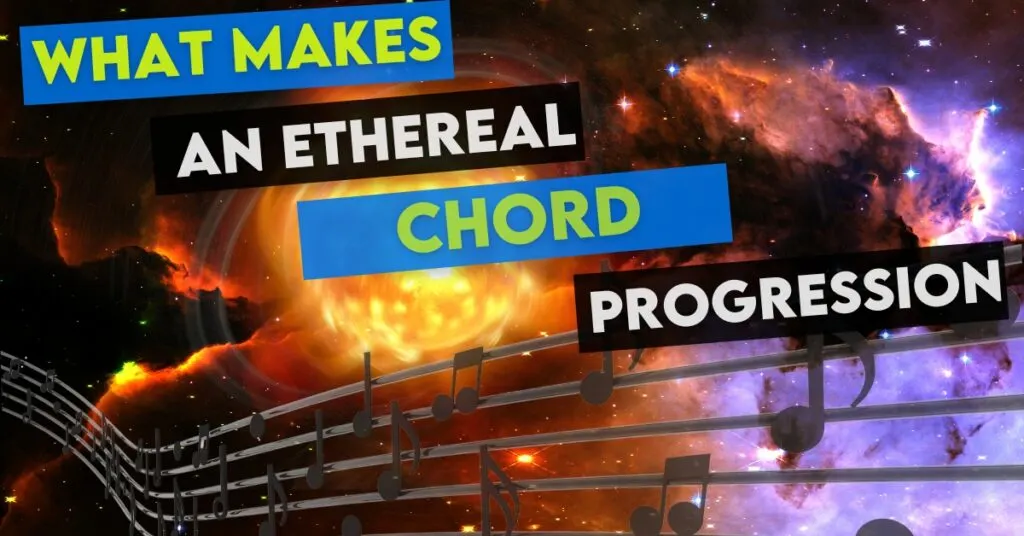KEY TAKEAWAYS
Ethereal chord progressions are sequences of chords often described as having a mystical or otherworldly quality to their sound. They can be created by utilizing uncommon chord voicings with more complex chords with at least 4-5 notes, like a Maj 9th.
Ethereal Chord Progressions
Did you know that many of your favorite classical compositions are actually simple combinations of very few chords?
Composers in the past hundreds of years have used the same small handful of chord progressions to create beautiful and moving songs, from Beethoven to Mozart to Bach to Chopin.
This guide will help you with everything from writing your first melody to properly harmonizing your chord progressions so that you can write your own ethereal chord progressions!
The Sound Of Ethereal Chord Progressions
We’ll start with simple principles and tips on how to write the chords themselves.
In the key of C, there are three main types of chords:
- Major
- Minor
- Diminished
These sound like the following:
- Major is happy and bright
- Minor is sad
- Diminished is tense
Now let’s look at some more complex chords:
Augmented and Suspended Dominant 7th
- Augmented is very intense and dramatic.
- Suspended Dominant 7th is dark, atmospheric, and tense.
You can use many combinations of chords to create ethereal music. Experimenting with all these different options can be very satisfying!
How To Write Ethereal Chord Progressions
Ethereal chord progressions are a great way to create an airy, mystical sound in your music.
At first, it can seem intimidating, but with a bit of music theory, it turns out to be a much easier task than it looks.
You can do this in several ways, but one common technique is using suspended chords. These are chords with both the major third and perfect fifth removed from the chord.
To suspend a chord, you must first determine which notes make up that particular chord.
Let’s take C as our example.
A C major triad consists of three notes: C-E-G.

To create a suspended version of this chord, we would remove the G (perfect fifth) and replace it with either F or Gb, depending on if we want a minor or dominant suspended chord, respectively.
So for our example, we would have F-A-C for our suspended version.

The second method for creating ethereal sounds is using stepwise motion instead of intervals.
The stepwise motion refers to when two successive chords share at least two notes between them.
For example, let’s say we wanted to change back to C after using a suspended version earlier.
We could use a stepwise motion by moving to Amaj7 (A-C-E), then Dm7(D-F#/Gb-A), and finally ending on C again.

When composing, try experimenting with different types of chords, such as a suspended chord, diminished chord, dominant chord, augmented chord, etc.
What Makes An Ethereal Chord Progression?

An ethereal chord progression is mellow and has a lulling, dreamlike quality.
It often involves sparse usage of major and minor chords substituted in their place.
There are no set rules to follow when writing an ethereal chord progression.
It can be hard to pinpoint exactly what they sound like, but if you’re trying to create an emotional response in your listeners, you’re on the right track.
The other thing about these types of chord progressions is that there’s not much movement or harmonic change throughout the song.
When we listen to a song with an ethereal chord progression, we want to feel suspended and emotionally connected while listening to it.
This doesn’t mean there isn’t any harmonic motion in the song because most songs will have a release point where things get tenser and/or dissonant before resolving back into tonic at the end.
You will generally want to stick to mostly exotic and harmonically rich-sounding chords. Think 7th chord, 9th chord, 13th chord, etc…
The goal is for the ear to be satisfied with the progression, even if there aren’t any melodic phrases present yet or if it doesn’t seem particularly busy or active harmonically speaking.
Check out this article on how to identify chord progressions by ear.
Creating Movement In Your Chord Progression.
One of the best ways to create movement in your chord progression is to use a secondary dominant. A secondary dominant is when you take one of the chords in your key (known as the primary dominant) and substitute another chord for it.
The chord substituted is a fifth away from the original while still staying in key. For example, if you’re using a C major key and want to create some movement with your progression, you can replace G7 with D7b9 or Db7.
These two chords have no accidentals and are perfect for giving your listeners something different without changing keys.
If you want to make things more interesting, try changing the key signature so that these chords are in their appropriate places within the scale.
The Power Of The III Chord
The III chord is the perfect chord to help you create an ethereal, hazy feel.
It’s also great for slowing things down and creating a sense of mystery. In fact, it was this chord progression that created the iconic Twin Peaks theme song.
A common way to use the iii chord is as a pivot point between ii-V chords or vi-ii-V chords. You can add iii chords between ii-V or vi-ii-V chords if you want something less jarring but still full of haunting feels.
Another option would be to replace a minor IV chord with a major iii chord.
Ideas for Inspiration
Here are a couple of methods you can try out for creating ethereal chord progressions.
1) Take any major chord progression, remove the three different notes that make up that key signature’s triad, and see how it sounds.
2) Starting with any major chord progression, substitute a few chords and leave others untouched. For example, say we have a simple i-vi-v-iii-iv progression of major triads. Substitute one, say, the Cmaj chord for a Cmin9 and Gmaj with G7sus4.
Related Questions
What Is a Lush Chord?
A lush chord is a chord that has at least four notes that occur every-other interval. An example would be a major 7th chord with notes on the 1st, 3rd, 5th, and 7th intervals.
Who Created the Mystic Chord?
The so-called “Mystic Chord” is a synthetic chord, most known for its use in various works by composer Alexander Scriabin.
Probably the most popular of these works is his piece titled “Prometheus: A Poem Of Fire,” which is heavily, if not entirely, based on the “Mystic Chord” (sometimes called the “Prometheus Chord”).
Fun Fact: Scriabin had deep beliefs of this chord and described it himself as a “chord of the pleroma,” which was “designed to afford instant apprehension of – that is, to reveal- what was in essence beyond the mind of man to conceptualize.
Its preternatural stillness was a gnostic intimation of a hidden otherness,” according to Wikipedia.
What Are the 4 Magic Chords?
I – VI – V – IV is often described as the four magic chords because it creates one of, if not the most, pleasing sounding chord progression. In fact, it has been used to create countless hit records throughout the last century.
Check out the following article to find out to play any song with four chords.

 Want to connect with other music producers for help and guidance?
Want to connect with other music producers for help and guidance?